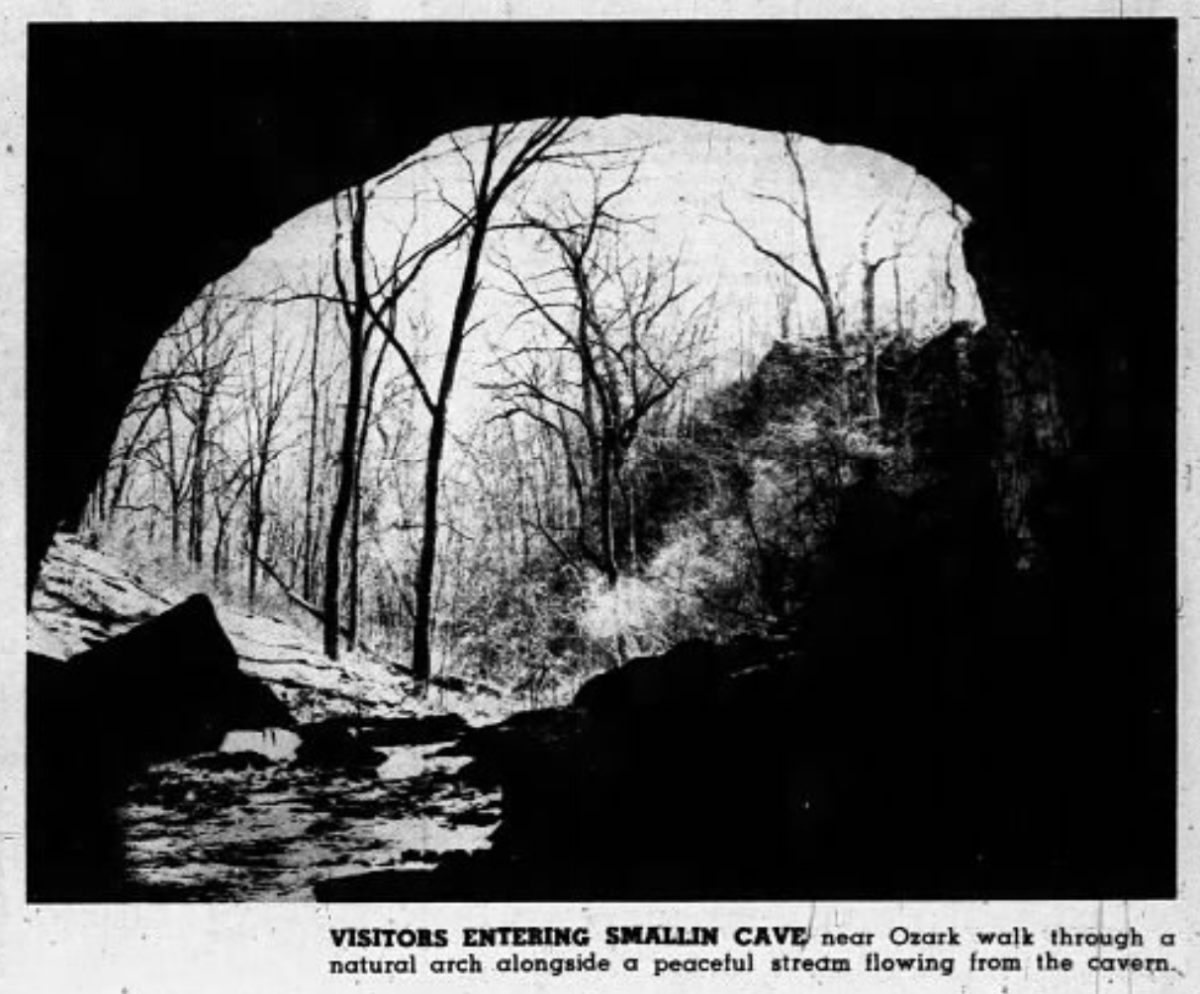Entering Smallin Cave represents a world of contrasts. Visitors see the cave from light to dark as they enter its mammoth mouth, spanning about 55 high by 100 feet wide, which leads to narrow passages where water frequently flows.
The contrasts also extend to its history, which represents both early and late: The Christian County cave was documented in the early 1800s by explorer Henry Rowe Schoolcraft, whose pen preserved some of the earliest recorded impressions of the Ozarks region available today. Its owners also believe that there are ties to Native Americans.
Yet, despite this early notoriety, it was not developed as a tourist attraction during Missouri’s “show cave” heyday. That came later — but today it offers visitors a living bridge to history.
“There’s all these layers and layers and layers of history in this cave,” says Kevin Bright, who owns the cave with wife Wanetta. “This cave was kind of the center of that natural commerce and trade as you traveled through the Ozarks.”
Today, the landmark is known as Smallin Civil War Cave. While no fighting happened within the cavern, it was in the middle of a region torn apart by the war.
“The thing about Missouri Civil War history is our history books don’t do justice to what happened here,” Kevin shares. “Everybody was affected; everybody was involved in the war. Especially in this area around here, Springfield had four forts and a fifth under construction. The road went south across the Finley River just below the cave right here, and there was a camp down here – Camp Brown. It was a 100-men cavalry unit, and their job was reconnaissance, going out looking for Confederates or bushwhackers.”
Smallin’s early history
As one walks up to the wooden building with “CAVE” painted in large letters, all to the cadence of bluegrass music, their steps are similar to ones feet have traveled for millennia.
“The archaeological materials that were recovered by the 2014 MSU field school (as well as previous artifacts found at or near the cave) reveal that Smallin Cave has a long history of human occupation, extending back at least 8,500 years,” notes a report in its application for the National Register of Historic Places, to which the cave was added in 2018. “The cave provided a large shelter and a reliable source of water.”
Much later, it was also visited by explorer Schoolcraft on his 1818-1819 trek through the Ozarks. Today, his journal is revered as one of the earliest written accounts of the Ozarks region. Within its pages is an entry about Smallin Cave, which he and fellow explorers visited on Jan. 1, 1819.
“On leaving Findley’s fork, we followed up a small deep valley, which in a short distance, and after a few windings, terminated suddenly in a cave opening on a hill-side the whole width of the valley, with a stream running from its mouth,” he wrote. “The first appearance of this stupendous cavern struck us with astonishment, succeeded by a curiosity to explore its laden recesses.”
Two centuries, six months and a handful of days later, Kevin met me above those recesses at the cave’s gift shop and visitors center. Guests were already arriving for tours, and panning for gold, watching a video about the cave and perusing the Civil War and Ozarks-related memorabilia while they waited.
The whole thing reminded me of what Marvel Cave — the heart of Silver Dollar City — was like before the development of the theme park that has helped push a pin for the Ozarks on a national map. Turns out, there’s a reason for that: Wanetta worked at the Branson theme park, first as a sign painter, and then as a manager of Marvel Cave.

Before folks visit the cave, they stop at the visitors center and gift shop.
The couple’s foray into ownership themselves began in 2009. It wasn’t strictly a love of caves, however, that led them to take on the project.
In fact, this is an era when the number of show caves in the state is lower than it’s been in the past. Instead, it was a call to ministry: The Brights wanted to buy a cave — not Smallin originally, but that deal fell through — to be part of developing a transition home for teenagers.
When the first sale didn’t work out, they heard about Smallin, which was owned and operated as a church camp by Central Assembly of God in Springfield. Maybe there was a way to join forces for multiple purposes, the Brights thought.
Central Assembly was open to the idea, Kevin tells me, but ultimately the deal didn’t work out – as a joint venture, that is. But the church still wanted the sale to go through, which it did in 2009.
Even though the Brights weren’t able to fulfill their dream of having a transition home on the property, they see what they do as a way to be of service to others.
“That was our dream. That door got absolutely closed, but everything we do is a ministry,” says Kevin of their early plans for the transition home. “The cave has been a ministry; young people come and work here, and families come here all the time. So it’s just kind of an open platform.”
Smallin’s role as a place of connection has seemingly been a through-line to its history. Young children grew old during Smallin’s heyday as a “local” destination: For picnics, and trips, and for days of washing clothes. (There were also more unconventional moments, like in 1891 when it was rumored that the cave would be transformed into a “ghost resort for spiritualists.”)
Far more often, it was a place for good community memories – ones so long ago that it’s likely few, if anyone, remembers them firsthand today.
“The Smallin Cave will again be the most popular resort for picnics and pleasure trips this summer,” noted the Ozark Herald in 1897. “Each Sunday, numbers of people drive up to the noted cavern and spend a few hours exploring its mysterious recesses.”
Change to a Show Cave
Smallin Cave’s start in show business seemingly began in 1950, when it was listed for sale.
It’s surprising that Smallin wasn’t developed in a commercial tourist destination by the early 20th century. This was in Missouri’s show-cave era, when many caves across the state – like Marvel, Fairy (today’s Talking Rocks Cavern), Bluff Dwellers Cavern and more – were “developed” and opened to the public as tourist attractions.
According to author H. Dwight Weaver, author of “Missouri Caves in History and Legend,” 43 Missouri show caves opened by 1960, and just seven between then and 1990.
Smallin was one of the latter. When it was listed for sale in the Sunday News and Leader in 1950, it was advertised as a “resort property,” and, with electricity now available, as “a potential money maker.”
It appears the cave was sold, and then sold again. In 1962, a Springfield newspaper article notes it was purchased for $150,000 by Tom D. Young, a Wichita oilman who came back to his former home – Springfield – but brought baggage along with him.
“Young said his purpose is to provide economic security for his family in the next few years,” noted the Springfield Daily News. “His reference was to his sentence to not more than five years in state prison at Lansing, on a Jan. 4 conviction by jury of fraud against four Yuma, Ariz., investors.”
The cave – then known simply as Civil War Cave – did eventually open, although it was later said to be owned by Joseph Bulger, who was not any more constrained by conventionality or ethics.
“Bulger’s interpretation of how the cave was utilized during the Civil War ranged from liberal to outright fantasy,” notes the cave’s National Register application. “For example, he purchased an old train car, placed it on the property and claimed it was President Lincoln’s funeral car. Lincoln’s (real) funeral car was destroyed by fire in 1911.”
Bulger’s influence, however, did not last long: He was killed in an airplane crash in 1966.
About a decade later, Smallin’s next chapter would begin: As a location for Sonrise, the church camp affiliated with Central Assembly. It would serve as a private retreat for campers for about 30 years.
Visiting Smallin Cave today
After meeting at the gift shop, Kevin and I head down to the cave.
Along the way, there are signs that share the history of the cave and the local area, such as of the vigilante Baldknobbers, Civil War stories, and of the Smallin family. Smallin Cave itself isn’t the only cave on the property: Disappointment Cave is there, as is Fielden Cave.
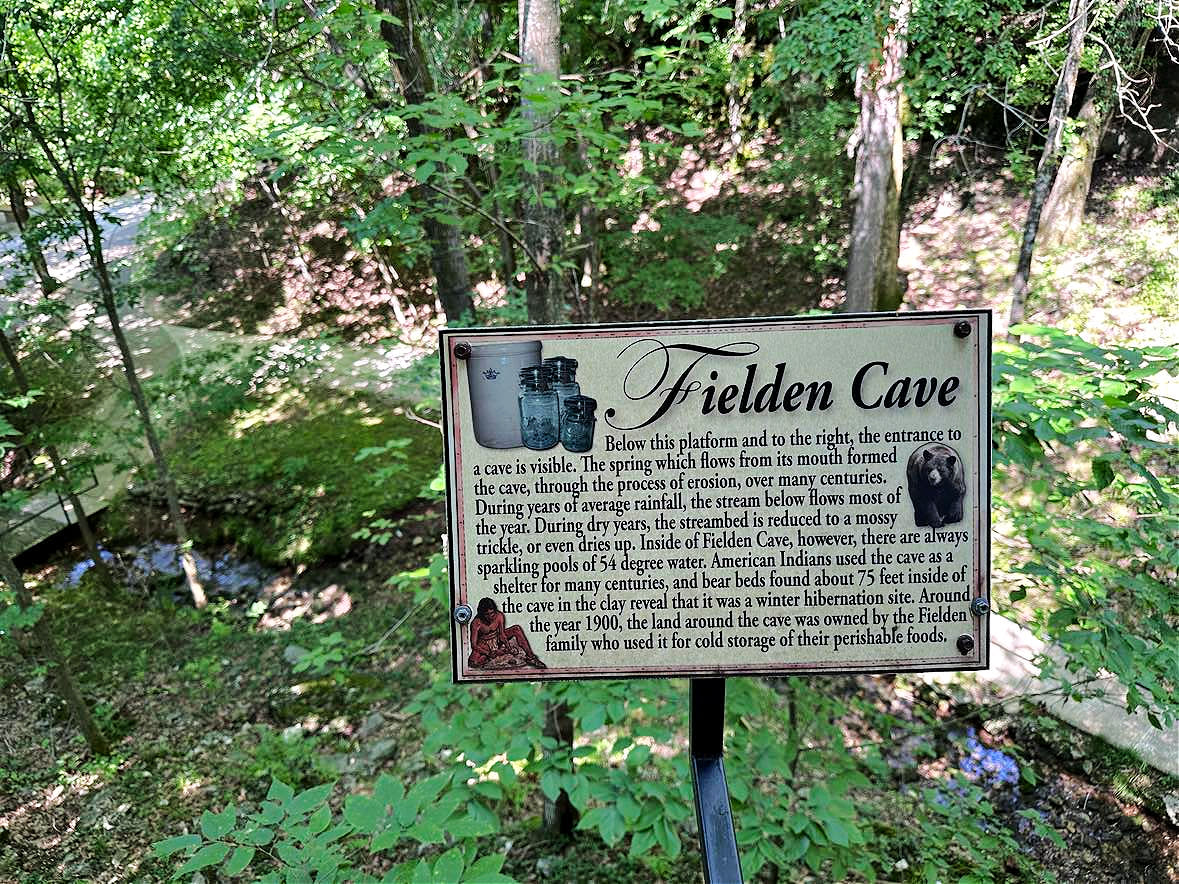
Signs sharing local history are found throughout the property.
“There’s a spring box in there put by the Fielden family in the 1890s,” Kevin tells me as we pass the latter. “When the Baldknobbers were hung, things had calmed down enough that people had gone back to farming and raising kids again, and the Fielden family showed up. They dug that cave out 20 foot and put a wooden box in there. That was the neighborhood refrigerator for years.”
Soon past that is Smallin. It’s an easy cave to access: A half-mile walk on a solid path takes visitors straight into the cave, where walkways give an even surface via which to see the sights.
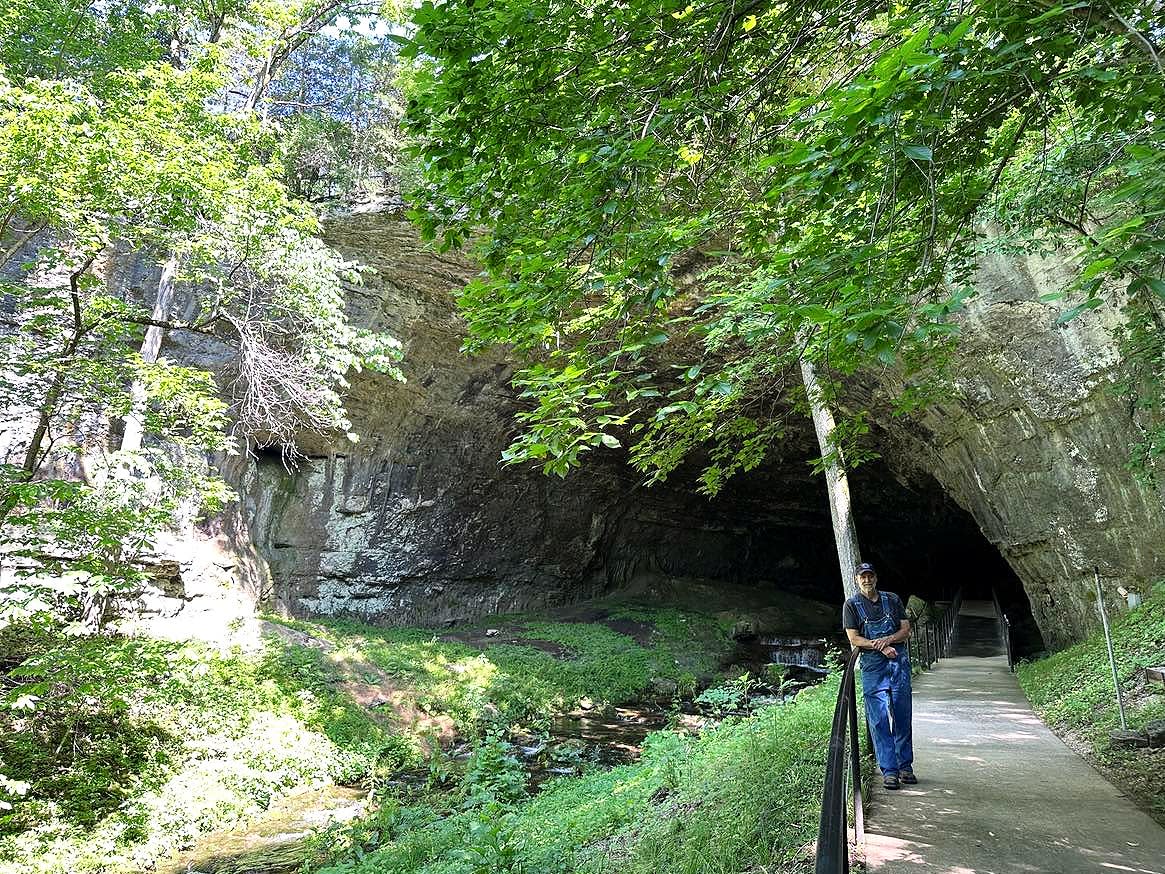
Kevin Bright stands at the entrance to Smallin Cave.
Those include the green, carpet-like rocks near the entrance where locals, Kevin tells me, once once regularly gathered. Those memories extended to one local woman in particular, who shared childhood memories from the early 1900s.
“She said one of her first memories was walking up, holding her daddy’s hand,” Kevin shared. “She said she remembered walking up and seeing the huge opening, and a patchwork quilt and colorful blankets, and all of the ladies that spread out a picnic. She said that’s what Smallin Cave looked like every Saturday afternoon – until the guy (previous owner) from Chicago showed up. The first thing he did was walk over and tell them they had to pay to use the cave.”
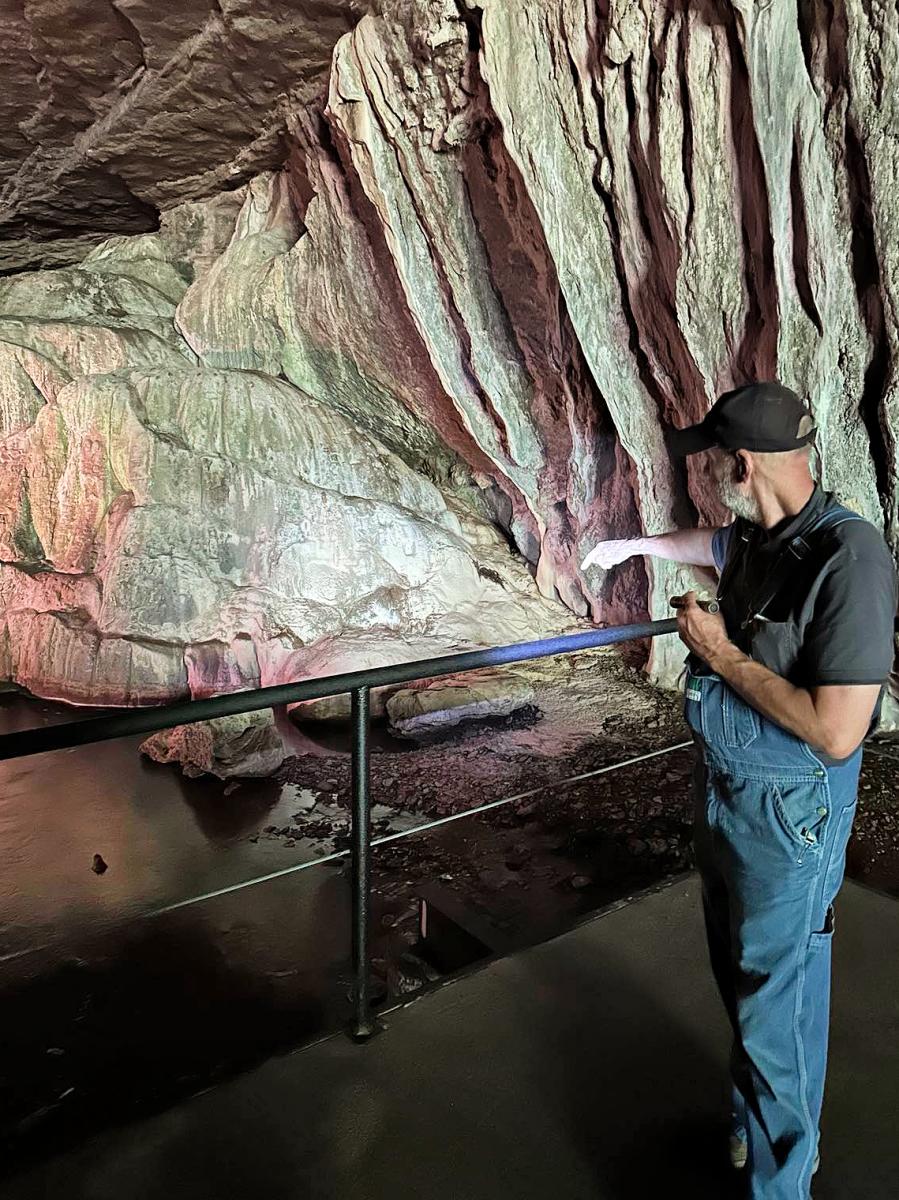
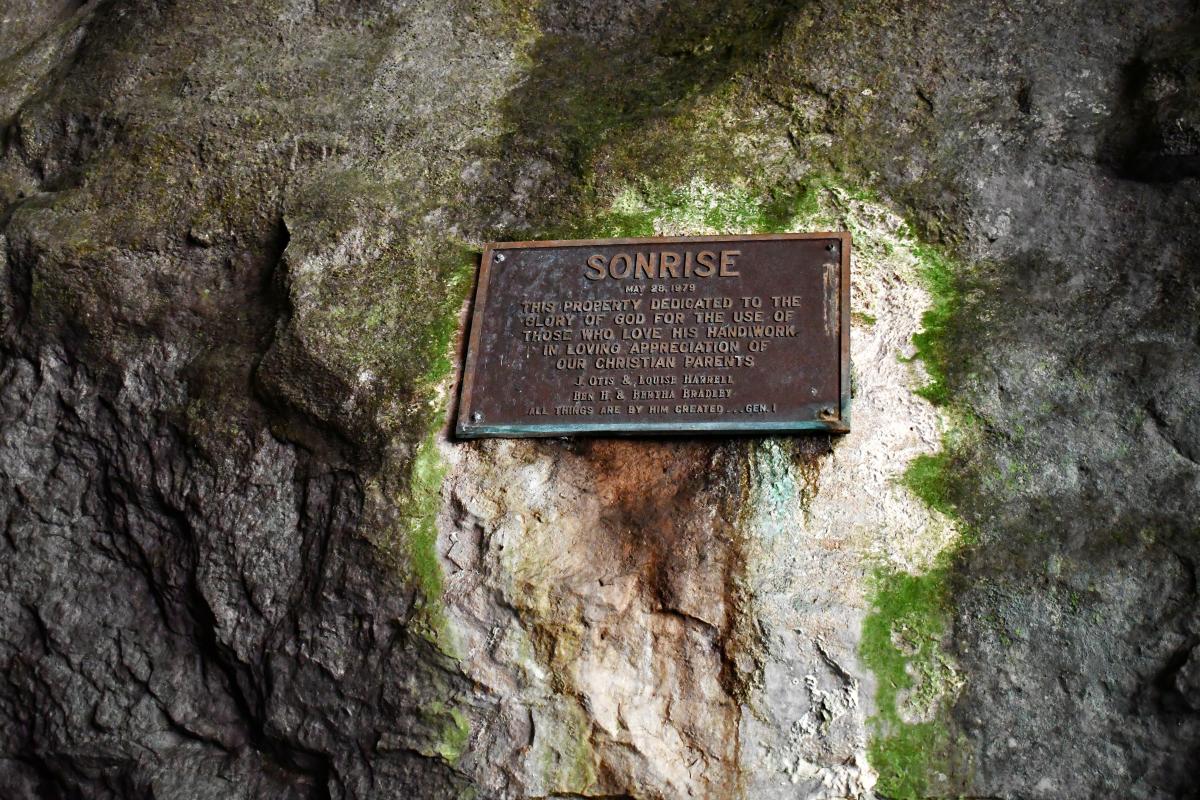
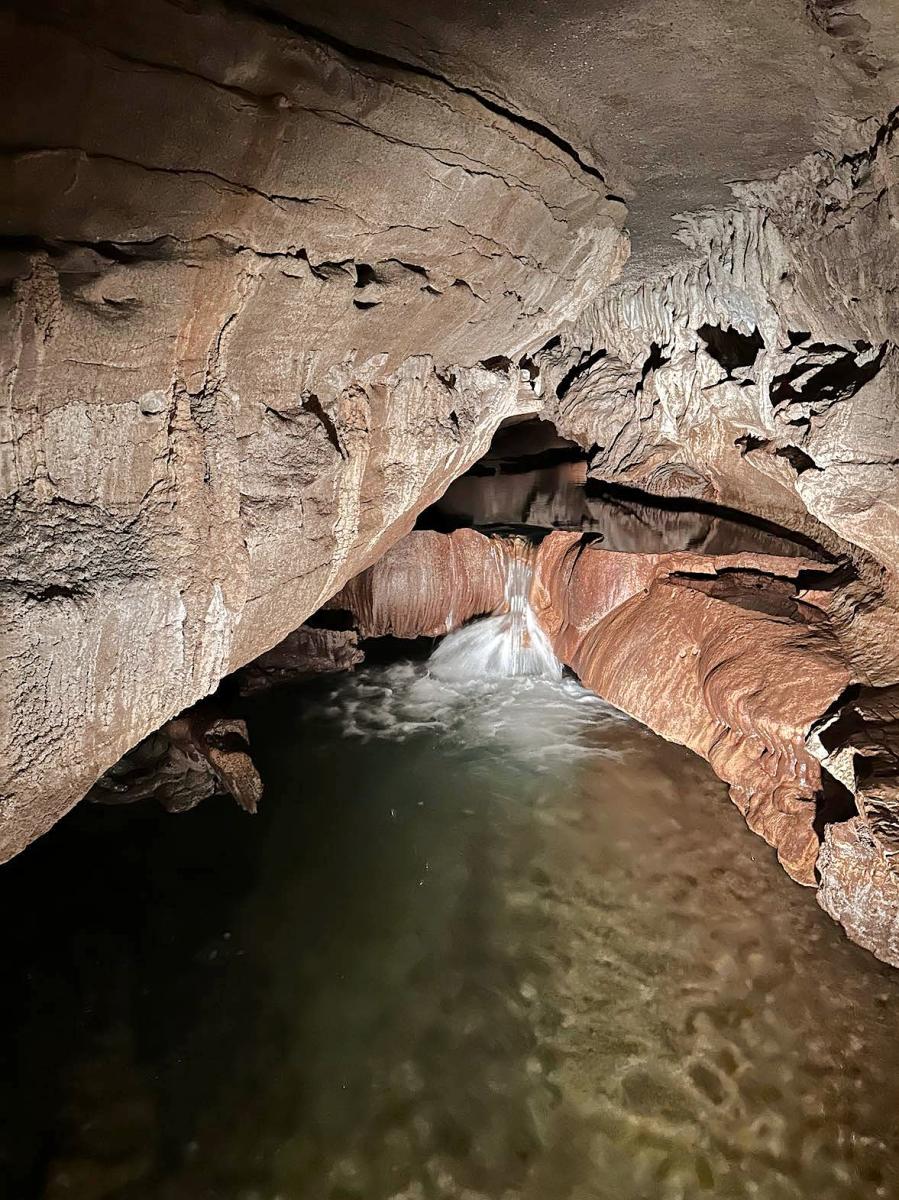
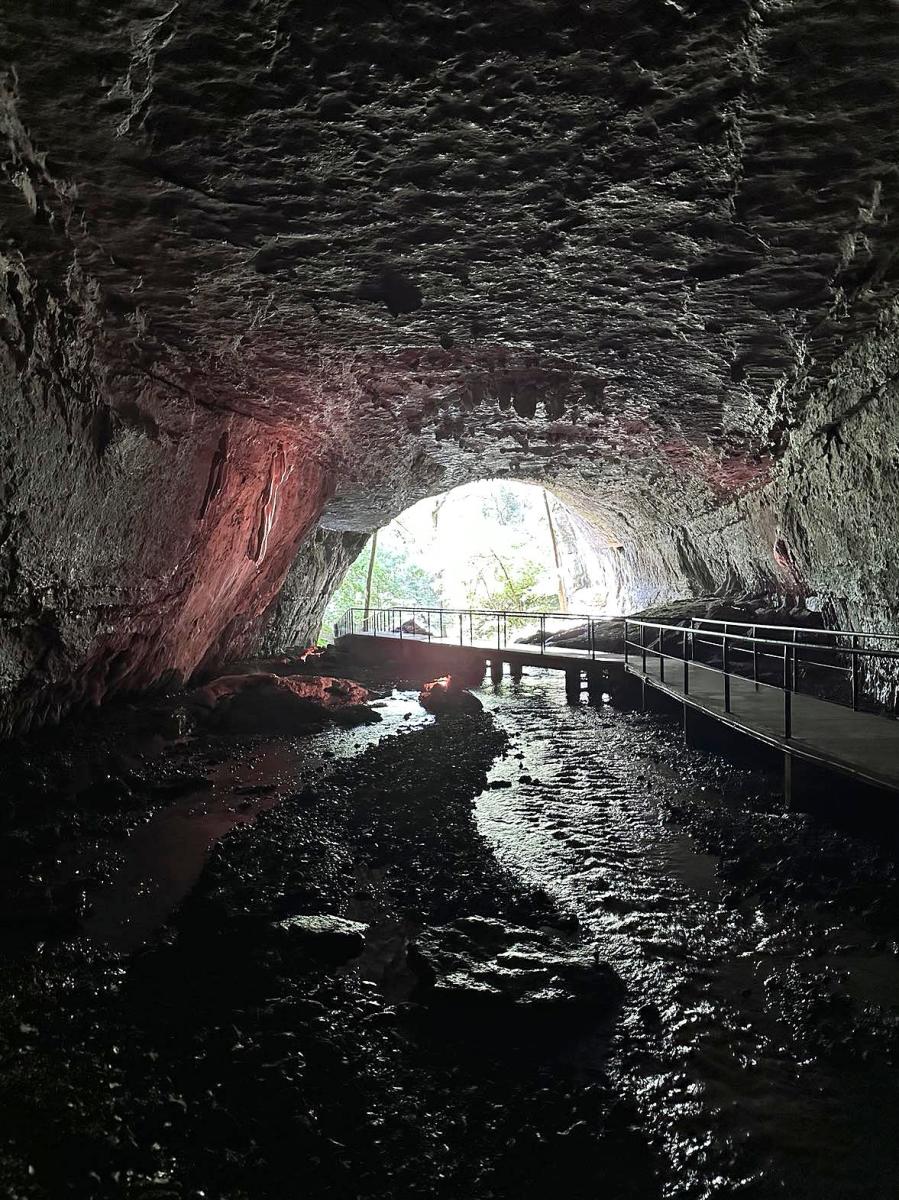
Views inside the cave show history and a unique Ozarks world.
There are other sights, too: Water that rushes and flows, initials from centuries-ago visitors, and creatures like blind salamanders – a staple at Smallin that were even nationally studied via the cave. Back in 1951, a local college professor took students to the cave annually to study cave life, and that year he took 23 blind salamanders to the Smithsonian Institute.
“The presentation resulted in a spread in the Washington (D.C.) Evening Star, and a picture sequence spread request from Life magazine which reached the lay-out stage, but was discontinued due to Korean (War) pressures,”
Another creature referenced in that article was the blind crayfish. Both are still present in the cave today – and hopefully, tomorrow. But the increasing development of rural surroundings also brings concern for the Brights, who have noticed changes in the cave, such as a lower crawfish population, and silt and dirt where water formerly ran clear.
They want the cave to remain an oasis of natural beauty, and a testament to history.
“There are kids who are from here who don’t realize they have something to really be proud of,” Kevin says of local pride in the Ozarks. “Everybody wants to be us, they just don’t realize it until they start hearing the history.”
Want to visit?
Click here to connect with Smallin Civil War Cave’s website.
Resources
“Chicago grand jury names cave owner killed in crash,” Springfield Leader and Press, Aug. 2, 1968
“Found: Salamander’s Paradise,” Matt Goree, Sunday News and Leader, July 15, 1951
“Missouri’s Mammoth Cave,” The Troy Herald, Dec. 13, 1876
”Missouri Caves in History and Legend,” H. Dwight Weaver, 2008
“New owner of area cave in legal jam,” Springfield Daily News, Jan. 13, 1962
“No ghosts wanted,” Springfield Democrat, Feb. 26, 1891
No headline, Ozark Herald, May 7, 1897
”Rude Pursuits and Rugged Peaks,” Henry Schoolcraft
Smallin Cave, National Register of Historic Places, 2018
“Wichita oilman buys Smallin Cave at Ozark,” Springfield Leader and Press, Jan. 12, 1962

